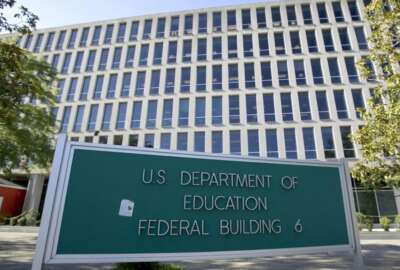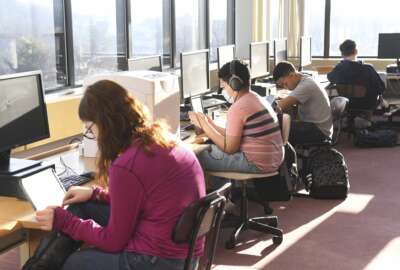Hubbard Radio Washington DC, LLC. All rights reserved. This website is not intended for users located within the European Economic Area.
On Air: Federal News Network
Trending:
How the Education Department could help improve falling math scores
Education performance in developed countries, and in the United States, is a mixed bag. That is according to the latest Programme for International Student Asse...
Education performance in developed countries, and in the United States, is a mixed bag. That is according to the latest Programme for International Student Assessment (PISA), a periodic project of the Organization for Economic Cooperation and Development. In the U.S., math performance by 15-year-olds was worse than in 2018, among the lowest ever. Reading and science held steady. For analysis of what the results mean, the Federal Drive with Tom Temin spoke with Ryan Tauriainen, the Executive Director of Teach For America’s D.C. region.
Interview Transcript:
Tom Temin Tell us a little bit about the PISA assessments. These come out periodically and they’re done internationally.
Ryan Tauriainen They come out every three years. And the PISA began in the year 2000. It’s an international test. It’s actually created in France predominantly. And what it does is it compares standardized test results in reading, math and science across over 80 different countries or locations in 2022, in fact, 620,000 15 year olds across 81 locales participated in the PISA. And as you mentioned, the report, the results from those tests just came out on December 5th.
Tom Temin So this is not a meta assessment of results reported by different nations with different systems. This is 650,000 kids everywhere taking the same test.
Ryan Tauriainen Yes, the same test. And of course in their national language. And interestingly enough, this test has really at forefront a literacy test, even when it’s focusing on math or science. And the focus of the test does change every three years. It is still, at its heart a literacy test. So this particular test that was taken in 2022, which was actually one year later than it should have been because of Covid 19, this test was focused more on math skills. But the thing that’s interesting about the PISA math test is most of the questions that are asked of students are in written form. So they may have to read a passage or even a story and be able to take data or information from what they read in order to answer the math questions. So it’s not a test where you’re going to see a bunch of equations and kids are going to do computations. It really focuses on their reading skills at the same time and also has them apply real world solutions to problems that they may encounter.
Tom Temin Now, the United States and the federal government in a number of different domains, including the Education Department, has been pursuing STEM and the idea of STEM math and science. And, you know, those are these are all math requirement types of topics. What should we take away from this in the fact that the scores dropped so badly for that particular test in the United States?
Ryan Tauriainen There’s a lot to take out of it. As you mentioned, the scores did drop. In fact, they’re 18 points lower this go around than they were when the test results were first released, the first time the PISA was done. Those test results released in 2003. And so all these years later and we’re actually on average performing lower in math than we were in 2003. The other thing I want to mention before I get into that is that some people would look at these results and actually think that the United States improved. Interestingly enough, because our ranking internationally grew, we actually moved up to being 26th in math, which previously we were in the 30s. So you may think that, oh, the United States did so much better. They’re improving. And in fact, what we’re seeing is it’s just that other countries decreased their scores even more than ours. They may have been more heavily affected by Covid 19. The effects of Covid 19 are something that’s very challenging for our school districts to improve upon. So, for instance, the hiring aspect of teachers is what’s really, I think, affecting these scores more than anything, especially in STEM. To put this in perspective, I’m going to speak specifically from my experience as a school and district leader in Washington, D.C. Hiring math teachers, STEM teachers is the most difficult out of all the positions. And it is especially difficult now because Generation Z, the generation who were becoming novice teachers these years when they major in STEM fields, they get offers for other types of work in other fields that are much more lucrative than teaching. So it can be extremely difficult to recruit someone who majored in math or computer science or some other type of science, and to come into teaching when they know the income level that they’ll be entering in is much lower than something that they could be doing otherwise. And so that has been the biggest challenge for schools in the United States, is actually being able to get STEM experts to fill these STEM classrooms. I can tell you multiple times, I’ve been in situations where we recruited a fantastic person who was passionate about education, really wanted to be a teacher, but did not necessarily have the strongest math background. And unfortunately, that was the position that was open. And at a certain point you have to fill that position and you may put somewhat in who is not the most comfortable with teaching math, but they do it because they really want to be a teacher. And you try your best to be able to build that person’s skills, to make them into the best math teacher they can be. But we’re still unfortunately lacking people who come in on day one with expertise in STEM fields. And so that’s really affecting our students, especially after the effects of Covid 19.
Tom Temin We’re speaking with Ryan Tauriainen. He is executive director of Teach for America’s D.C. Region. He’s also a former White House fellow with the Education Department. And is there any policy or operational change? I mean, the Education Department has permeated itself deeper and deeper into smaller and smaller aspects of public education over the decades. And public education seems to be getting worse and worse in the outcomes over the ages here. So what could happen at the federal level to improve the situation, do you think?
Ryan Tauriainen One of the things I learned when I worked at the federal Department of Education is how frustrating it can be because there is usually all carrot and no stick is what we sometimes would say at the department. So education in the United States is very much controlled at the local level, at the state level, and very little of it, unfortunately or fortunately, depending on your outlook, can be decided at the federal level. Now, one thing that the federal government, I believe can do, and I do think that Secretary Cardona has addressed this, is that in the wake of Covid 19, one of the strategies that we know is actually having a strong effect in improving scores, whether in reading or math, is high dosage tutoring. That is pretty much a no brainer. One would say like, oh, yes, if students get more face time and that’s independent or in very small groups with a with a tutor or a teacher, they’re likely to improve upon their scores. And absolutely, it makes total sense. The problem was where are the people? Where is the money to fund this? Well, because of money that came out of the Cares Act, such as the ESEER Fund, the Elementary and Secondary Education Emergency Relief Fund, and the GEER fund, which is the Governor’s Emergency Education Relief Fund. There was billions and billions of dollars dumped into education the years of and following Covid 19. And a lot of that money could be spent on creating and hiring programs to provide one on one or perhaps three on one tutors for the students who had the most decrease in their math and reading. And we are seeing firsthand in D.C. that is probably the intervention that is having the most effect on students. So I believe that the federal government could do more to put money towards or providing grant money towards creating and paying for these high dosage tutoring programs, especially in schools that suffered the most learning loss.
Tom Temin Yeah, that’s remarkable because you say that, you know, billions and billions and billions were poured into education during the Covid as part of relief. And yet look at the scores and look at the results, you know, at the local education level were pretty bad. And I think a lot of school districts are still digging out. So what you’re saying is the federal government should redirect maybe its focus on where funds go in, what educational function to actually have some leverage in making scores go up.
Ryan Tauriainen Yes, absolutely. I think in that first round of over $20 billion going towards public education, the thing that we have to remember is very little of that was actually going towards the education process. It was actually going towards refurbishing and remodeling buildings so that when students came back, they would be able to function, they would have proper ventilation, they would have all the PPE and the sanitary aspects of the school to make sure that we weren’t passing along viruses and diseases. That was obviously becoming the focus of the world at that point. And so a lot of that money actually went into remodeling the entire buildings of schools, sometimes building entirely new structures. So that’s where the money went at first. Yes, absolutely. And then after that sort of round of remodeling happened is when people started to focus more on the after school or during school programs that could improve on the education of their students. Unfortunately, like, that’s still in its birth stage, I would say, where it’s still very, very new. So that’s where I would invest more dollars right now.
Tom Temin Yeah, because I guess it’s easier to measure how many cubic feet per minute your new air equipment is moving or how many filters you installed or how many new buildings you put up than it is to measure education outcomes. That’s longer and more subtle, isn’t it?
Ryan Tauriainen It is. And unfortunately, we were you know, we were doing distance learning for a year to two years or longer in some places. And unfortunately, in many of our rural communities, that wasn’t really an option. They may not have had the infrastructure for Internet access for every student to have a laptop. I’ve met superintendents from very small districts who really inspired me because they went above and beyond creating these mobile Wi-Fi devices that were sent through with busses and literally bus drivers would park their bus in front of places where kids could work on laptops that were donated. It was amazing that things that went forward in order to meet the need at the time. So it just shows how resilient we are as a country and how inspiring we are for our students and our children. And right now that everyone’s back in the building, we need to be doing everything we can to put more teachers and more adults in front of kids to help build their scores.
Copyright © 2024 Federal News Network. All rights reserved. This website is not intended for users located within the European Economic Area.
Tom Temin
Tom Temin is host of the Federal Drive and has been providing insight on federal technology and management issues for more than 30 years.
Follow @tteminWFED
Related Stories
Exclusive
Workforce Rights/Governance
Read more
Related Topics
All News
CARES Act
Department of Education
Elementary and Secondary Education Emergency Relief Fund (ESEER)
Federal Drive
Governor's Emergency Education Relief Fund (GEER)
Management
Organization for Economic Cooperation and Development
Programme for International Student Assessment (PISA)
Ryan Tauriainen
STEM
Teach for America
Tom Temin
Related Stories
-
After telework cuts, Education Dept. staff see little benefit from more office time Workforce Rights/Governance
-
House Republicans want to freeze hiring at the Education Department Federal Newscast





